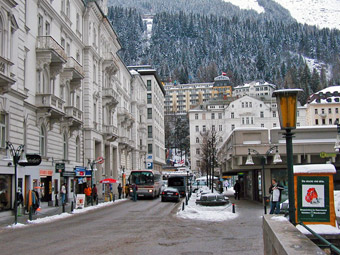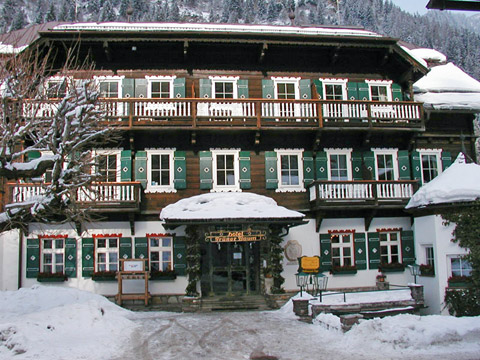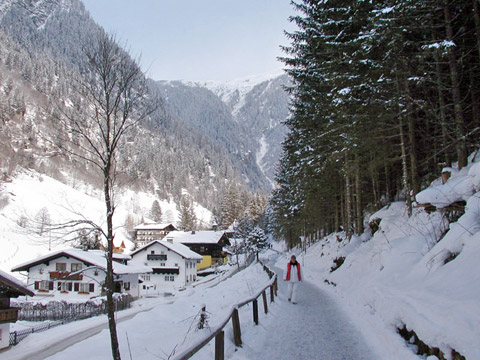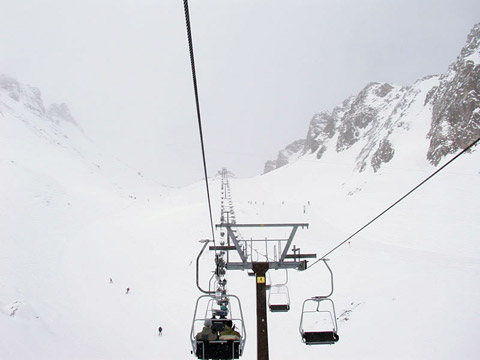Ski the World: Bad Gastein, Austria
By John Sherwood, DCSki ColumnistFebruary 27, 2005

Strolling down the Kaiser Wilhelm promenade in downtown Bad Gastein, I spotted two young skiers with full avalanche gear walking next an elderly couple in bathrobes. A study in contradictions, Bad Gastein nevertheless functions well as both a world-class ski destination and spa town. The area possesses a month’s worth of skiing for all ability levels, serene spas, shopping, and easy access by rail to Salzburg and Venice.
A few years ago, a knowledgeable SkiEurope representative tried to sell me a ski trip to Bad Gastein, his favorite ski area. When I mentioned the idea to my wife she asked, “Do you really want to go to a place filled with casinos and old ladies in fur coats?” We ended up at St. Anton. Ever since that experience, Bad Gastein has piqued my curiosity. “Why would an expert skier from Austria love the place so much?” I ruminated. By the 2004-2005 season, we had skied enough of the Austrian Alps to begin exploring some venues less well-known to North Americans.
When I arrived at Bad Gastein, my spirits sank a notch. Our hotel, the Villa Excelsior, exuded the faded elegance of a European spa town: belle epoch architecture, padded doors, a creaky bed, and oriental rugs. Once I stepped out onto my balcony and gazed out at the Gastein valley, my attitude began to change. Yes, this is a place where sick people have come for hundreds of years to sit on balconies and cough their lungs out, but sickness is part of life. Seeing people coming away from treatments after a day on the mountains made my time there more special. It emphasized how fortunate I was to be able to experience a mountain on skis, and that these experiences will not last forever. Deep thoughts, but not as deep as the snow I would soon encounter.

We devoted our first day of skiing to Stubnerkogel (2,246 meters/7,368 feet). This mountain sits directly above the main rail station at Bad Gastein, and from it, one can take huge runs back to the town or cross over to Shlossalm, a mountain with even more skiing. Schlossalm and Stubnerkogel reminded me a little of Ischgl because they offered ample skiing both above and below the tree line. My favorite run was the intermediate (red) H1 trail from Hohe Scharte to Bad Hofgastein. On this usually empty piste, one can bag a mind-boggling 4,700 feet of vertical. To return to the Hohe Scharte summit (2,300 m/7,545 f), you will ride a funicular train, a cable car, a high-speed detachable quad, and a double chair. In short, you will experience the totality of the mountain and its various forms of uphill transit.
While heading up the mountain on a slow double (I needed the rest), the lift suddenly ground to a halt. I immediately whipped out my camera and started snapping pictures, but became distracted by some British kids in the next chair yelling, “Go For it.” I looked behind me and suddenly saw a girl boarder jump off the chair into a huge mound of fresh snow. The young woman hit the snow hard and did not move for a few moments, but she soon poked her nose out of the snow and started giggling.

Over a Gasteiner beer at our next hotel, the Gruner Baum, I discussed my skiing options for the following day with Markus Papai, a manager from the tourist office. “Do you like steeps and no people?” he inquired. “Steep is neat,” I replied. “Head to Graukogel, the site of the 1958 Alpine World Ski Championships. The area only has two fixed grip doubles and a Poma, which turns a lot of people off, but the skiing is epic.” Epic proved to be an understatement.
Graukogel was a Warren Miller inspired fantasy - the kind of skiing I dream about but almost never experience. It was snowing hard when we arrived at the mountain at 9:30 in the morning. We jumped on the first double, which took us to the mid-station, and then continued on the second one to the Graukogel top station at 2,492 m/8,175 f. Seeing several telemark skiers skinning their way up the 4,000+ vertical feet of the mountain was good sign. Those freeheel types know how to sniff out the pow.
It was snowing a little less as we traversed to the beginning of the red B2 trail and sunny holes in the clouds began to appear - “sucker holes” as experienced Alpine skiers often call them. I will never forget what greeted me: a huge powder field that extended all the way to the shelf-like summit of the mountain. Those lucky freeheelers were going to get an additional 500 vertical feet of powder by summiting the mountain but I was content with the knee-deep powder on the marked piste. About 700 vertical feet later, powder turned into tree-lined corduroy. Once known as the land of tracked out slopes, Europe now surpasses North America in grooming. In contrast to North America, many older people in Europe continue to ski and these folks demand buffed pistes. For those who hate grooming, however, there’s always off-piste terrain, which is almost endless in the Bad Gastein region.
We quit skiing a little early on our last day to explore the town and our new hotel, the Gruner Baum (green tree). Unlike many hotels in Bad Gastein, Gruner Baum was not a grand spa hotel but more of a Tyrolean chalet set apart from the town in a small valley. A dry land cruise ship, Gruner Baum offered nearly everything a guest could want: private Nordic trails, a horse drawn sled, a thermal pool, and even curling. Trays of pastries, plush sofas, and a roaring fire greeted skiers returning from the slopes. Dinners were six course extravaganzas featuring everything from venison to Wiener schnitzel.

Our favorite aspect of the hotel was how close in distance it was from Bad Gastein yet far away in atmosphere and attitude. Set in the narrow valley of Kotschachtal at the edge of the Hohe Tauern National Park, the hotel sat at the doorstep of the high Alps. Using a trail made popular by German Emperor Wilhelm I when he visited the area in the nineteenth century, one can be in downtown Bad Gastein in just 40 minutes by foot. The trail passes through the enchanting Spruce groves teaming with rare birds. Strategically placed feeders attract the birds, allowing twitchers to get some nice views. I saw some European Chicakees, Titmouses, a beautiful red-breasted male Eurasian Bullfinch (also known as a Gimpel), and a reticent Eurasian Jay. When the promenade gets within 200 meters of the town, the whole Gastein valley opens up before you with its snow-capped peaks and historic towns of Bad Gastein, Bad Hofgastein, and Dorfgastein.

In the three days we stayed in Bad Gastein, we barely explored a fifth of the 200 kilometers of marked trails. We never skied the above-treeline terrain at Sportgastein or the intermediate pistes at Dorfgastein, which is linked to yet another huge ski domain called Grossarl. One could visit the Ski Amade alliance of 28 resorts a hundred times and never ski it all. The place is that big. You’ll have to ski to believe it.
(Photos by John Sherwood.)
About the Author
John Sherwood is a columnist for DCSki. When he’s not hiking, biking, or skiing, he works as a historian at the Naval Historical Center. His newest book, Afterburner: Naval Aviators and the Vietnam War, was recently published by the New York University Press. To read other articles by John, click here.

